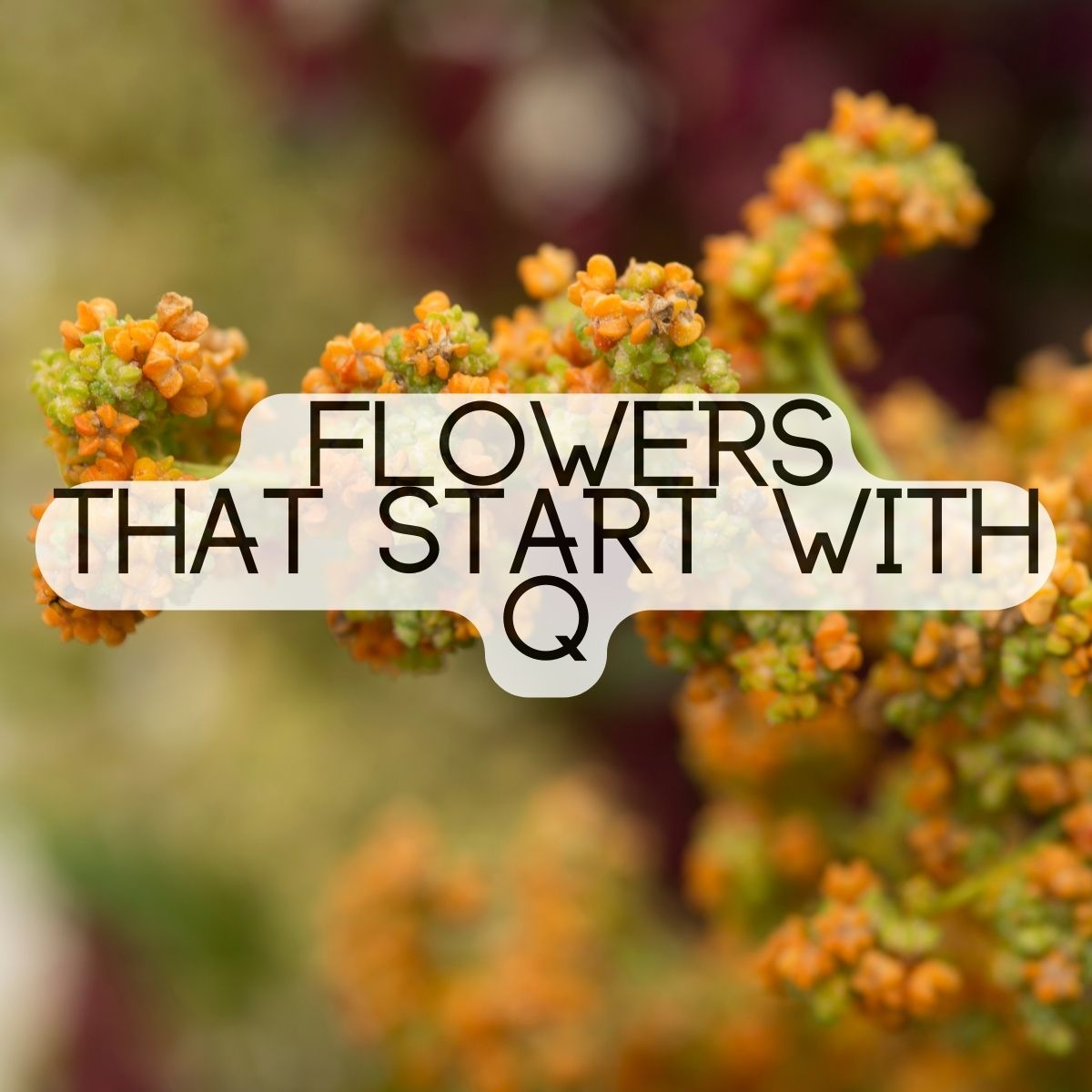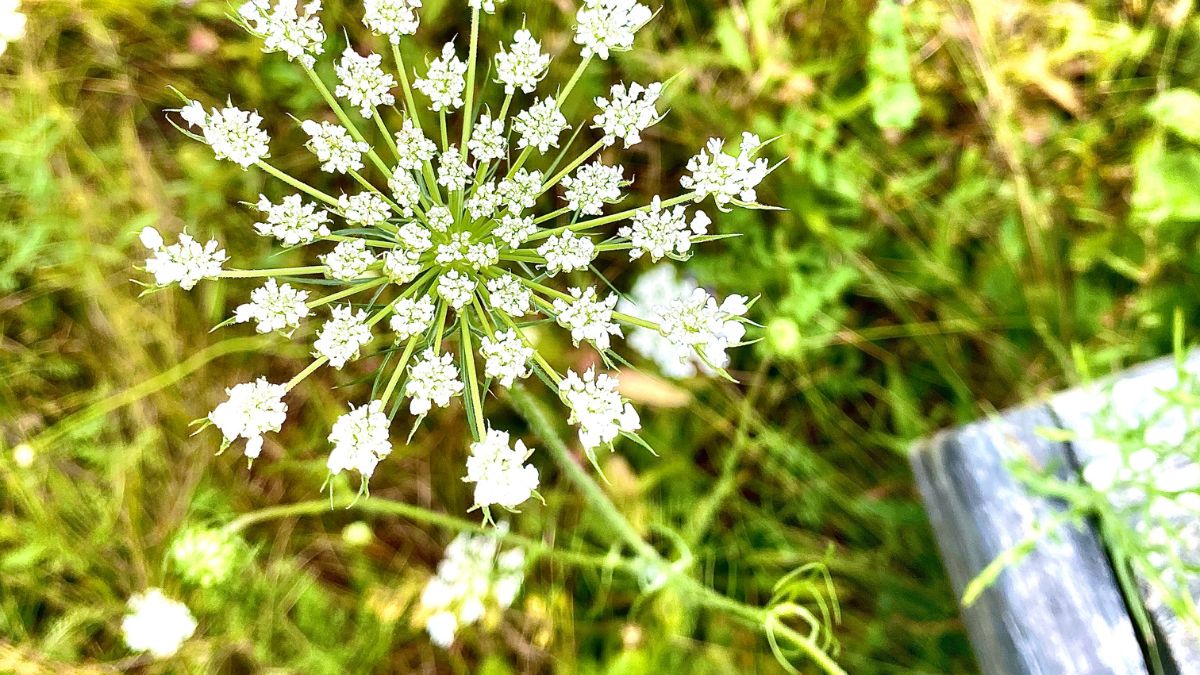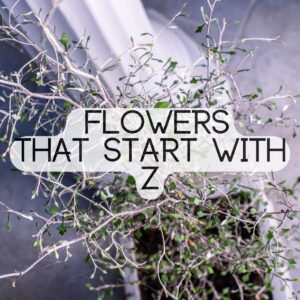These flowers that start with Q add so much beauty to any patio, yard, or landscaping with their vibrantly colored blooms and beautiful foliage! From the surprising quinoa plant to gorgeous Queen's tears quaker ladies and one of my personal favorites, Queen Anne's lace!

Read Next
8 Quality Flowers That Begin With The Letter Q
Quinoa
Scientific Name: Chenopodium quinoa
Type Of Flower: Herbaceous Annual
When Do They Bloom? Summer
Quinoa isn’t often thought of as a plant, but it is! Quinoa grows deep root systems that help support its thick stems. It produces a triangular bloom that is full of edible seeds. Its blooms are apetalous, meaning that it doesn’t have petals.
Grown all over the world, this low-maintenance plant is great for people who live in colder climates or food deserts. Quinoa can grow in temperatures ranging from 25 degrees Fahrenheit up to 95 degrees Fahrenheit, which is why it can grow in more than 70 countries!
Quick Fact: The seeds of the quinoa plant are often used as a substitution for rice or lentils!
Queen’s Tears
Scientific Name: Bilbergia nutans
Type Of Flower: Evergreen
When Do They Bloom? Spring
Queen’s tears is a great addition to indoor and outdoor growing spaces. It has a shallow root system that allows it to be grown in small pots, planters, window boxes, and patios. You can expect its lovely trumpet-shaped blooms to have an ombré effect from top to bottom, ranging in color from pink, blue, to green.
This plant thrives in moist soil and humid environments. Regularly watering or misting can help in regions that have low humidity. Place the queen's tears out of the direct sunlight to help its flowers stay bold and healthy. Partial indirect sunlight should be enough to keep this plant happy and healthy.
Quick Fact: Queen's tears are also called the friendship plant!



Quick Fire Hydrangea
Scientific Name: Hydrangea paniculata
Type Of Flower: Deciduous Shrub
When Do They Bloom? Summer & Fall
The quick-fire hydrangea is a unique plant that produces upright blooms that sit atop long, thick stems. Its flowers start as white or pale pink and deepen in color to a dark shade of purple as the season progresses. They are known to be used in bouquets and vases due to their upright stature and sturdy stems.
Plant quick-fire hydrangeas in an area that can receive ample sunlight. They don’t tolerate full direct sun and heat; partial shade can be equally as appealing. They prefer moist soil that is well-draining and requires water every few days to keep the soil wet but not soggy.
Quick Fact: Quick-fire hydrangeas are toxic to humans and pets.
Quaker Ladies
Scientific Name: Houstonia caerulea
Type Of Flower: Perennial
When Do They Bloom? Spring
Quaker ladies are small plants that produce lovely purple and white flowers that have yellow centers. Their blooms consist of four petals, and their stems are upright and thin. They are considered wildflowers and grow well in rock gardens and wooded areas.
These plants thrive in sandy, acidic soil and can even tolerate rocky soil types. They can be grown in full or partial sunlight and prefer moist conditions. Quaker ladies are native to Nova Scotia and Canada and are commonly found growing in the Appalachian mountains.
Quick Fact: Quaker ladies are also called azure bluets!



Queen Anne’s Lace
Scientific Name: Daucus carota
Type Of Flower: Biennial
When Do They Bloom? Spring, Summer, & Fall
Queen Anne’s Lace is an ornamental plant that grows fern-like foliage and tiny white and purple blooms that cluster together, giving it the appearance of one large flower. This wildflower is grown across Europe and the United States, but certain regions consider it to be an invasive species.
This plant grows best in areas where it can take over and be free to spread. It is very easy to grow and should be grown by gardeners who appreciate it, or else you will be spending a lot of time pulling and redirecting its new growth! Soil conditions can vary as long as it’s well draining and it can tolerate full or partial sun.
Quick Fact: Queen Anne’s lace is also called wild carrot!
Quinine
Scientific Name: Parthenium integrifolim
Type Of Flower: Perennial
When Do They Bloom? Summer & Early Fall
Quinine is a wildflower that grows across the United States and is known to have medicinal properties. It has clusters of small white flowers that grow on top of its branch-like stems and soft green foliage. These plants are known to attract flies, so planters' beware!
Quinine favors hot conditions and can thrive in full sun or partial shade. Soil conditions should be well-drained and fertile with a good view to watch its pollinators such as hummingbirds and butterflies!
Quick Fact: Quinine is also called wild quinine and wild feverfew!



Queen Of The Meadow
Scientific Name: Filipendula vulgaris
Type Of Flower: Herbaceous Perennial
When Do They Bloom? Summer
The Queen of the meadow plant is an easy-to-care-for plant that is found all over the world. It is a medicinal plant that produces elegant clusters of small pink or white flowers that pair well with its fern-like foliage. They often grow to be one to three feet in height and can have an equal spread of around two feet.
Growing Queen of the meadow plants is simple as long as they have the right growing conditions. Plant them in dry, well-draining soil. Be sure that the soil doesn’t hold too much moisture, and place them in an area where they can soak up at least six hours of daily sunlight.
Quick Fact: Queen of the meadow plants are also called dropwort meadowsheet plants and Queen of the prairie plants!
Quesnelia
Scientific Name: Quesnelia quesneliana
Type Of Flower: Herbaceous Evergreen
When Do They Bloom? Spring
Quesnelia is a true beauty! Its deep green leaves surround its single red or white bloom, which truly adds a pop of color in all the right places! This plant is native to Brazil and can be grown both indoors and outside. Not only does this plant have showy foliage and blooms, but they also produce orange berries.
Quesnelia plants should be grown in moist soil and watered regularly to help their deep green foliage stay shiny and healthy. They require moderate amounts of sunlight but don’t mind a little bit of shade, either.
Quick Fact: There are 22 species of Quesnelia!





Comments
No Comments